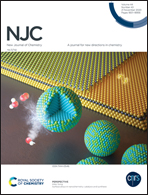Sustainable route for the synthesis of flower-like Ni@N-doped carbon nanosheets from bagasse and its catalytic activity towards reductive amination of nitroarenes with bio-derived aldehydes†
Abstract
Utilization of abundantly available biomass to develop advanced materials and products has become an utmost priority these days. Herein, we developed a sustainable route for the synthesis of Ni nanoparticles loaded on N-doped carbon nanosheets using underutilized sugarcane bagasse, urea and NiCl2·6H2O as the carbon, nitrogen and Ni source. The synthesized catalyst was characterized using different analytical techniques; FESEM, elemental mapping and HRTEM analysis revealed the formation of flower-like carbon nanosheets containing uniformly distributed nickel nanoparticles with average particle size of 2.4–10 nm. The synthesized nanocatalyst was used for the one-pot reductive amination of different bio-derived aldehydes with the nitroarenes at 100 °C for 4 h. The complete conversion of the variety of nitroarenes with the formation of imines and benzimidazole products was obtained under optimized reaction conditions. The catalyst was recyclable up to five times with negligible loss in selectivity towards imines.



 Please wait while we load your content...
Please wait while we load your content...